The answer is yes and no. Let me explain my goofy answer. The pond in question is a pond 100 x 300 and five feet deep. Currently has one diffuser in the middle of the pond and a 4.6 cfm compressor. And the specific question was about adding a larger compressor producing 11 cfm. The 100 x 300 pond should have at least two diffusers but more like three diffusers due to the depth. (CFM = Cubic Feet Per Minute)
Going from 4.6cfm to 11cfm would provide plenty of air and the boils you see now would be much larger and a little higher, plus it would move a lot more water, if that amount of air did not tear the diffusers first.
The down side of too much is we could start to move too much water and disturb the bottom sediments ending up with suspended particles in the water column making the pond look cloudy.
Another point to look at if replacing the compressor is that being only 5’ deep you could use a linear diaphragm compressor, they are much more quite and less on energy use. Look at it as a high volume low pressure output unlike the piston compressor which is high pressure low volume.
I have been testing out the different compressors over the years in my big pond with 4 diffusers, deepest depth is 9’ and the 5.2 cfm linear compressor does move the water but the depth is a little too much on the linear compressor and saw decent boils but not what I would like. I did a quick test using a 8.5cfm linear and it was like day and night with the boils being much larger and moving much more water. I am currently using a 1/3 HP piston type with 4.3 cfm which moves gives me a nice size boil and feel I’m getting the water movement I need judging the boil size and ripples through the pond. At some point I will may be putting in a linear that pushes around 7cfm and will settle down with that size, but still a little concerned about the depth putting too much load on the diaphragms, or plan to rebuild it every couple years.
The other thing to look at is the diffuser and the amount of diffusers in the pond. Depth of water is the first factor to look at, the deeper the pond the more water will be moved. The bubbles coming from the diffuser will be pushing, pulling and en-training water as they race to the surface. A 12’ deep acre pond can be aerated with a ¼ hp piston type compressor with 1.7 cfm, which would be moving about 3800 gallons per minute at the surface. Looking at the 100 x 300 pond 5’ deep we would not be moving as much water and would need to add more diffusers to ensure we get the water movement and that there are no stagnant areas in the pond. At minimum I would use three diffusers along the 300’ length but four would be better coverage. Plus the pond is only 5’ deep we can use a linear diaphragm compressor since the back pressure will be within range of the compressor. These linear compressors are a lot more quiet and a little less on energy use.
Taking a look at our horse shoe pond I have four diffusers could possibly get away with three diffusers by putting one in the middle at the bottom of the “U”. The 100×300 I would look towards 3 to 4 diffusers right down the center of the length.
Then the type of diffuser makes a difference as well. There are a few different styles, shapes, materials and sizes of diffusers, starting with a stone diffuser which was the original diffusers used, do work but if the pond is a dirty pond or has a lot of minerals the stones could become clogged very quickly and need to be bathed in acid to clean them.
For years now a lot of companies have switch to rubber membrane diffusers. There are two different shapes, one is a round disc and the bubbles come out of the flat surface on the top of the disc. The second is a round tube and the bubbles come out from around the tube.
Example of system and to see shallow diffusers take a look at these pages which show the complete systems, Shallow pond Aeration system (AirMax) and Shallow Pond Aeration System (EasyPro)
Over all the depth the most critical, a round pond 12’ deep and the diffuser in the middle would be aerated with a ¼ piston type compressor
because of the depth of water the air bubbles have more time and distance to push, pull and entrain water from the sides to the surface. So the deeper the pond the less diffuser used and the shallower the more diffuser are used. Keep in mind each diffuser will need its own run of tubing from the compressor so each diffuser can be adjusted to produce the same size boil on the surface of the water.
Let’s look at why we need to control each diffuser. Here’s a pond with two levels one area is 10’ deep and the second diffuser location is 5’ deep. When we fire up the compressor and both valves are full open, the 5’ deep diffuser will take all the air because it has the least amount of resistance due the less water pressure than the 10’ deep diffuser. So we slowly turn the valve to the off position until we see the 10’ deep diffuser starts to produce a boil. Only adjust the shallow diffuser valve to make each boil look the same size.
One more look at the diffusers used for pond aeration, shallow or deep pond aeration. Most of our experience has been with the tube type diffusers and have not had too many problems with them. What we have heard of is most likely the water make up chemistry but once replaced no problems. The other problem with the tube type diffuser we ran into big time this year was turtles attacking them, tearing them and ending up with large bubbles that do not move the amount of water as the smaller bubbles are designed to do. The disc type diffuser seems to be a little more turtle proof since they cannot really get their mouth around the diffuser.
We are also working a new diffuser design and material as seen in the above picture, it’s white in color. Plus the addition of protection from turtle.
I hope I answered the question, can I put too much air/oxygen in the pond and hopefully explained the differences of aerating a shallow pond and deep pond with the different compressors livable.

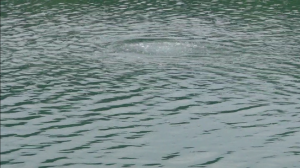
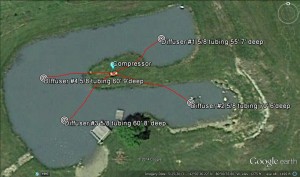
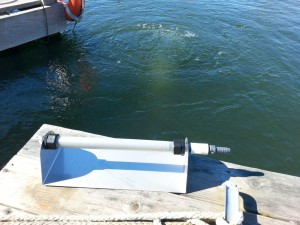
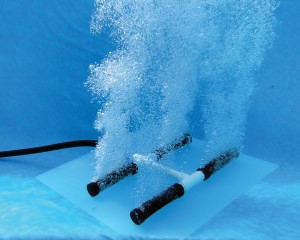
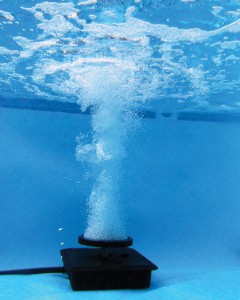
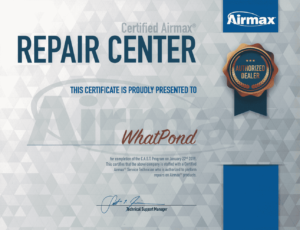
Comments on this entry are closed.
Our pond we add well water we were told there is no air in the well water find is 4540 by 6 foot deep how much air should we add to this
HI Dave, you heard correct on well water and springs do not have oxygen. Your pond is six feet deep and the size is 45′ x 50′? Feel free to use the contact page to reply and if you can send a picture along. At minimum we would most likely use a shallow pond (linear diaphragm) compressor and possibly one or two diffuser’s. The goal to achieve is 5=6 pp for game fish. Doesn’t seem like much but even dropping to 3-4 ppm the fish become stressed. Location like northern or southern states also make somewhat of a difference too, along with the nutrient loading and how much decomposing debris is in the pond. Please shoot us an email using the contact form along with the pond address and picture of the pond if you can.
Darrell
Hello,my name is Tom we have approximately 60ftx30ft pond 7ft deep was wondering with one would you recommend thank you.
HI Tom, Good question and you are at a depth that bring questionable decision on what type of compressor. Linear air compressors are good to 6′ of depth. Piston type compressors can go up to 30. Yes there is a price difference as well.
With the linear type compressor going deeper than 6′ will require more frequent rebuild of the compressor diaphragms. So if you wanted to go with the linear type compressor I would recommend the PA8SWN with two diffusers. Place each diffuser a 1/3 of the way in from both ends of the 60′ length. Hopefully at those points the water will be shallower?
If you would rather go with a piston type compressor and not worry about depth then the PS10 would be the way to go.
Thank you for asking and hope this helps.
Darrell